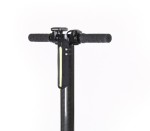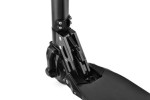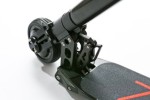Difference between ZERO 2.0 and other carbon fiber scooters
The amazing success of the ZERO 1.0 carbon fiber electric scooter in Oct 2015 created a huge influx of replica/clone carbon fiber copycat scooters which based their design on the ZERO 1.0. The design was so simple and elegant that it was truly quite easy to replicate. These carbon fiber replicas are known by many names such as Jack Hot, Aleoca etc.
However, the cheap carbon fiber scooter replicas come at a high risk for the consumer in terms of safety and ease of repair. Read on to find out.
1. Complexity of Repair
The ZERO 1.0 was immediately phased out after 6 months of release due to the complex nature of the repairs and the instability of the electronic system. The vibrations when riding the ZERO 1.0 damaged the ESC boards and batteries which were not properly shock protected.
And to repair it was a big headache. Watch how difficult it is to repair the ZERO 1.0 scooter:
The ZERO 2.0 has improved shock absorption inbuilt into the design where there is a complete removal of wires and modular parts are simply plugged in to connect each other. Compare that to the ZERO 2.0. See how easy it is to change any part on the ZERO 2.0 due to its modular design:
2. Design Changes
The ZERO 2.0 is inspired by the modularity and minimalistic Apple design concepts of the iPhone.


The dashboard design between the ZERO 1.0 (and other replicas) and ZERO 2.0 has changed drastically. The separate brake and LCD/throttle readout control panel on the first version and other replicas has been thrown out the window.
The ZERO 2.0’s control panel is now a fully integrated, APP controlled interface. This integrated design makes the control panel cleaner and more elegant without ugly wires sticking out of the LCD and brake throttle. It distills everything down to the basic functionalities of what interface is most relevant to a rider.


The headlights for the ZERO 1.0 and other carbon fiber replicas all have a separate on/off switch amongst the other many switches on the LCD control panel.
In comparison, the ZERO 2.0 has a single Red button that controls EVERYTHING including power on/off, headlights, speed control etc. similar to the single home button that you see on your iPhone.


The replica carbon fiber scooters also base their design on the ZERO 1.0 folding design which requires the user to pull out a latch on the folding frame of the scooter. There is risk in the original design in that over time, wear and tear will cause the latch to weaken and loosen the folding mechanism.
The ZERO 2.0 uses a step folding function to fold the scooter making the transition between riding and folding much easier and quicker. The user simply has to use his foot to step on the latch to fold the scooter.
100% of the ZERO replicas are based on the flawed ZERO 1.0 design. The ZERO 2.0 model has so far had very good feedback. Even when defective, the fix is very simple and only takes 5 mins for any part to be replaced. The best part is, anyone can do the fix and doesn’t require soldering or technical know how!
3. Warranty Period
Lastly and most importantly, most of the replica carbon fiber escooters only come with one month or even one week warranty. Rarely do they extend a longer period warranty for these replicas as they break down very easily with expensive electrical faults. Repairs are not easy and are expensive.
The ZERO 2.0 comes with a ONE YEAR limited warranty on electrical parts and components. The manufacturer stands behind their product in terms of reliability and quality. Even for parts that are not covered under warranty, repairs are comparatively a breeze and hence cheaper to fix.
You can find out more about the ZERO 2.0 and ZERO 1.0 here.
*UPDATE: Quality differences between the cheaper copycats and the original ZERO are detailed in this latest article, Why Cheap Carbon Fiber Scooters Are a Danger.*
